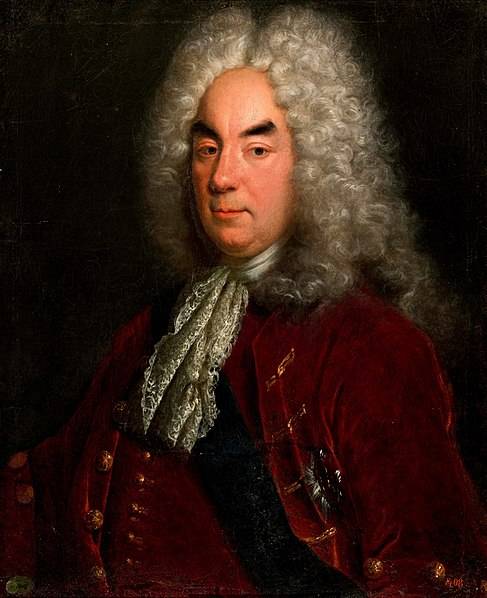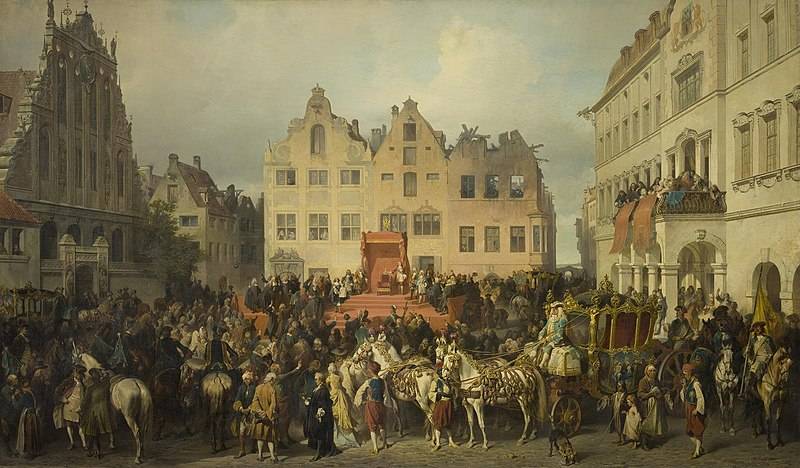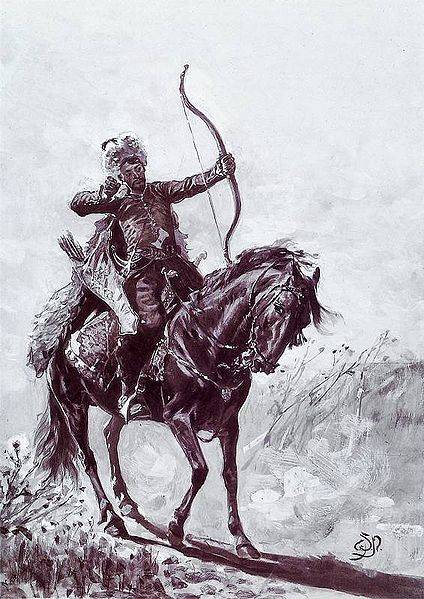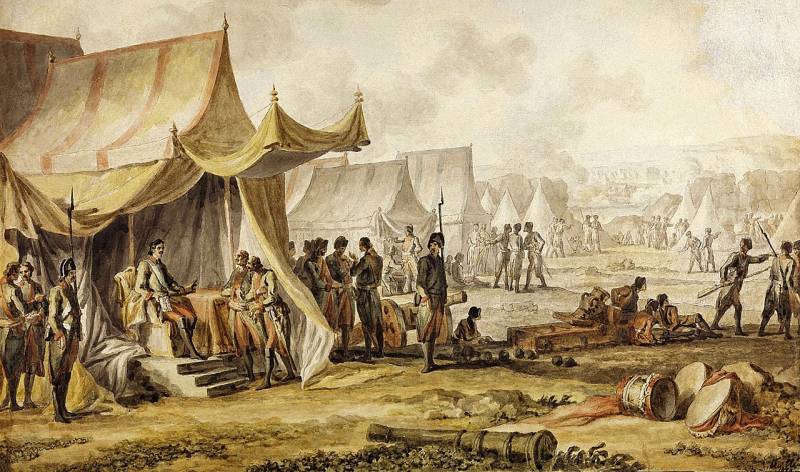War on two fronts. Prut campaign of Peter I
Russia and Turkey
In 1700 Russia and Turkey signed the Constantinople Peace Treaty. Russia received Azov with the district, preserved new fortresses (Taganrog, etc.), and was freed from the transfer of gifts to the Crimean Khan. The lower reaches of the Dnieper were returning to Turkey. This agreement allowed Peter Alekseevich to start a war with Sweden. However, during the Northern War, the threat of a second front in the south remained. Therefore, in the summer of 1701, Prince Dmitry Golitsyn was sent to Istanbul in order to persuade the Sultan's government to give Russian ships free passage in the Black Sea. Golitsyn's mission was unsuccessful.
Moreover, in the Port, the positions of supporters of the war with Russia were strengthened, who wanted to use Moscow's unfavorable position and return what was lost in the Northern Black Sea region. Tsar Peter sends Peter Tolstoy to Constantinople to collect information about the situation in Turkey and to restrain Sultan Mustafa from war with Russia. Tolstoy found out that the main enemy of Russia at the Sultan's court is the Crimean Khan Devlet-Girey (ruled 1699-1702, 1709-1713). Khan wanted to organize a campaign against the Russians while they were fighting the Swedes.
The Russian envoy, with the help of money and sables, contributed to the party, which at that moment did not want a war with Russia. Devlet was removed from the Crimean table, he was replaced by Selim. In 1703, Sultan Mustafa died and was replaced by Ahmed. At this time, within the Ottoman Empire, several powerful groups were fighting for power, the grand viziers were replaced almost every year. The Sultan was afraid for his power, and he had no time for a war with the Russians.
However, France and Sweden continued to put pressure on Porto to get the Ottomans against the Russians. The success of the Russians in the war with Sweden alarmed the Sultan's court. In 1709, Devlet-Girey, a supporter of the war with the Russian kingdom, was again put on the Crimean table. The Crimean Khan supported the desire of the Cossacks and Hetman Mazepa to oppose Russia, using the invasion of the Swedes. After the defeat of the Swedes in the Battle of Poltava, Devlet allowed the Cossacks to settle in their possessions. Also Istanbul was alarmed by the strengthening of the Russian fleet in the Azov Sea. In 1709, the Russian ambassador to Constantinople, Tolstoy, repeatedly sent alarming messages to Moscow that Turkey had begun active preparations for a war with Russia. The same information was received from Vienna. Warships were feverishly built, the Janissary corps was strengthened, and military supplies were transported across the Black Sea to the borders of the Russian kingdom. In the Asian possessions of the Turkish Empire, camels and mules were purchased for the transport needs of the army.

Russian diplomat, ambassador to Constantinople (1701–1713) Pyotr Andreevich Tolstoy
The intrigues of Charles XII and the declaration of war
After the Poltava disaster, the Swedish king Charles XII fled to the sultan's domain. He offered the Sultan an alliance against Russia. He promised to send an army of 50 to help the Turks. Hetman Mazepa assured the Ottomans that as soon as the war began, the whole of Ukraine would rise up against Peter.
The Sultan's government, which for almost nine years watched as the two great northern powers depleted each other, believed that the Russo-Swedish war was beneficial to Turkey. But Poltava tipped the scales in favor of the Russians, and the Porta considered the strengthening of Russia extremely dangerous for itself. Therefore, now the Ottoman dignitaries listened with great attention to the myth of the Swedish king that he had a 50-strong army and the stories of the Ukrainian hetman about the uprising in Ukraine. Tolstoy had no choice but to sound the alarm and call on Moscow to concentrate the army in the southwestern direction.
East is a delicate matter. A new political turn has taken place in the Port. In January 1710, Tolstoy reported to Moscow that the Sultan received him with great respect and that "love has been renewed" between the powers. Preparations for war with Russia were stopped. Turkey even agreed with Peter's proposal to remove Charles and the Cossacks who fled with him from the Sultan's possessions. The Peace of Constantinople was confirmed.
Calm in the south made it possible to intensify actions on the northern front. On January 28, 1710, the Russian army took the Elbing fortress. The siege of the powerful Vyborg fortress began. On June 14, Peter, at the head of the Preobrazhensky regiment, entered Vyborg. On July 4, 1710, the surrender of Riga was signed, one of the most powerful fortresses in Europe, which had been besieged since the autumn of 1709. The capture of Riga allowed Sheremetev to throw part of the troops to siege other fortresses. The fall of Riga demoralized other Swedish garrisons. On August 8, the commandant of Dunamünde surrendered, on August 14 - Pernov, on September 8 - Kexholm (Korela).
The victorious campaign of 1710 in the Baltics ended with Reval's surrender on September 29. All the fortresses were taken with little blood (except for the pestilence, which took many lives of Russians, Swedes and local citizens). The Russian army captured colossal trophies: about 1300 guns of various calibers, tens of thousands of grenades, cannonballs, gunpowder stocks, etc. Livonia and Estonia were cleared of the Swedes.

Riga's oath of allegiance to Russia in 1710. A. Kotzebue
Nothing foreshadowed complications, and Peter even dreamed of a "good peace" with Sweden.
On November 20, 1710, Sultan Ahmed III, under the influence of France, Sweden and the Crimean Khan, declared war on Russia. The king frightened the Sultan that the Russians, having crushed Sweden, would soon seize the Crimea, occupy the Danube principalities and march on Constantinople. Charles XII did not skimp on territorial concessions, at the expense of the Commonwealth. Porte promised several regions, Kamyanets, an annual tribute. Karl hoped that the war with Turkey would bind Russia, allow Sweden to rebuild its military forces, launch a counteroffensive and recapture the lost lands and fortresses. The French strongly supported the efforts of the Swedes. The Austrians reported that the French "did not cease to incite Porto with the greatest impudence" on the Russians. The Crimean "party" also strenuously demanded to start a war with Russia.
The Russian ambassador Tolstoy was thrown into prison. Crimean Khan Devlet began to prepare a campaign against Ukraine. He was supposed to be supported by the troops of Hetman Orlik, who replaced the deceased Mazepa, and the Poles of Pototsky (opponents of Russia and supporters of Sweden). In the spring of 1711, the Turkish army was also to act against Russia.
It is worth noting that the Porta clearly missed the most favorable time for the war with Russia. The Turks with the Crimeans could invade Little Russia in the months when Charles XII was there with his elite army and was not defeated at Poltava. Then Russia would have had a very hard time.

Crimean Tatar horseman. Polish artist Vaclav Pavlishak
War on two fronts
The news from Porta, of course, did not please Tsar Peter. The successes achieved in the north foreshadowed a close peace, now the end of the Northern War was postponed indefinitely. The Russian tsar tried to avoid the war in the south. He turned to the Sultan with a proposal to restore peace. He resorted to the mediation of England and Holland to conclude peace with Sweden on rather modest conditions: the Russians were left with only their ancestral lands - Ingria, Korela and Narva. For part of Finland, Sweden received compensation. Livonia with Riga departed to the Commonwealth. However, these proposals of Peter did not receive support.
Convinced that there were no ways to peace, the tsar ordered to move the troops from the Baltic to the south. The commander of the army in the Baltic States himself, Sheremetev, remained in Riga for the time being to strengthen the Riga garrison. From Petersburg, where the sovereign was at that time, couriers hurry to Sheremetev, Golitsyn and Apraksin. The tsar ordered the Azov governor Apraksin to put the fleet on alert, prepare plows for the Don Cossacks, and attract Kalmyks and Kuban Murzas to repulse the Crimeans. Sheremetev was instructed to move troops from the Baltic to the area of Slutsk and Minsk and further south. Knowing the slowness of the field marshal, Peter convinces and urges him on, demands speed. Peter instilled in the commanders that they would have to fight the Turks differently, more with infantry and fire. Prince Mikhail Golitsyn led the dragoon regiments, Sheremetev - the infantry.
When the military preparations were basically over, and there was no hope of restoring peace, Tsar Peter Alekseevich on Sunday February 25, 1711 in the Assumption Cathedral promulgated a manifesto declaring war with Turkey. After the prayer service, the Russian tsar as a colonel of the Preobrazhensky regiment, having drawn his sword, led this regiment himself. On the same day, the guards began a campaign to unite with the main forces going to the Danube.
The grandiose march of the Russian army to the south was accompanied by great difficulties. The army set out from Riga in January 1711, that is, the carts and artillery first went by a sled route. Sheremetev left Riga on 11 February. Sheremetev's military travel journal notes that he had to travel in a carriage or in a boat. Spring came early, the flood began. The roads fell into complete disrepair: they had to drive either on virgin soil or at night. When the snowfalls and rains ended, great warmth and stormy floods began. In many places it was only possible to get around by boats. This detained the field marshal in Minsk for 15 days. The tsar left Moscow on March 6 (17).
The invasion of the Crimean horde. Hiking to the Kuban and Crimea
In January 1711, the Crimean horde (about 80 thousand horsemen) left the Crimea. Khan led half of the troops to the Left Bank, the rest of the troops, led by Mehmed-Gir, marched on the right bank of the Dnieper to Kiev. The Crimeans were supported by several thousand Orlik Cossacks, Poles (supporters of Stanislav Leshchinsky) and a small Swedish detachment. Also on the Left Bank Devlet counted on the support of the Nogai detachments from the Kuban. The Russians had on the Left Bank 11 thousand soldiers of General Shidlovsky in the Kharkov region, Apraksin's troops near Voronezh and several thousand Don Cossacks. The Crimeans did not dare to storm the Belgorod and Izyum fortified lines in order to break through into the depths of the Russian lands, and in March they turned back.
On the Right Bank, the Crimeans, Orlik, Cossacks and Poles were at first successful. There were few Russian troops here. They captured several fortifications, defeated Butovich's detachment, expelled by Hetman Skoropadsky. Orlik's troops occupied Boguslav and Korsun. Colonel Samus of the Boguslavsky regiment, colonel of the Korsunsky regiment Kandyba, colonel of the Uman regiment Popovich and colonel of the Kanevsky regiment Sytinsky went over to Orlik's side. However, soon quarrels began between the allies. The Cossacks did not trust the Poles, who wanted to return Ukraine to the Commonwealth. The Crimeans thought more about robbery and seizure of the city than about war.
On March 25, the Crimeans and Orlikovites approached the White Church, where there was a small Russian garrison (about 1 thousand soldiers and Cossacks). The Russians repulsed the assault and made a strong sortie. The allies suffered heavy losses and chose to retreat. After that, the Crimean horde took up what they loved - robbing and capturing people for sale into slavery. Many Cossacks preferred to desert, defending their villages from the Crimean predators. When the commander of the Russian troops in Ukraine Dmitry Golitsyn gathered 11 dragoon and infantry regiments to repulse, in April the troops of Mehmed-Girey and Orlik retreated to Bendery, to the Ottoman possessions. The Russian cavalry overtook some of the Crimeans and recaptured several thousand prisoners.
The Russian command organized two raids into enemy lands. In May 1711, an expedition of the Kazan governor Pyotr Apraksin set out from Kazan - 3 infantry and 3 dragoon regiments (over 6 thousand people). In Tsaritsyn they were joined by auxiliary forces, the Yaik Cossacks, then the allied Kalmyks. In August, the Kuban Corps of Apraksin (over 9 thousand Russian troops, plus about 20 thousand Kalmyks) left Azov and went to the Kuban, diverting part of the enemy forces from the Danube Theater. In August-September, the Russians and Kalmyks defeated the Crimeans, Nogai and Nekrasov Cossacks. The eldest son of Khan Devlet, Kalga-Girey, suffered a heavy defeat. Russian-Kalmyk detachments devastated the Nogai uluses. Then Apraksin returned to Azov.
After repelling the attack of the Crimean horde on Ukraine, the Russian troops under the command of Buturlin organized a counteroffensive. At the end of May 1711, 7 infantry regiments and 1 dragoon regiment (over 7 thousand soldiers), with the support of 20 thousand Skoropadsky's Cossacks, went to the Crimea. The trip was poorly organized. The movement was hampered by a huge baggage train necessary to supply troops in the Wild Field. At first it was planned to go to the Crimea through the Sivash, but the ships in the required number were not prepared to cross the gulf.
The Crimeans acted in the rear of the Russian troops, which blocked Perekop. The supply was disrupted and there was a threat of famine. In July, the troops of Buturlin and Skoropadsky returned back.
To be continued ...
- Alexander Samsonov
- https://ru.wikipedia.org/

Information